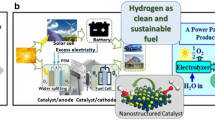Abstract
This paper deals with the fabrication and electrochemical study of a high temperature solid electrolyte supporting cell operating as SOFC (Solid Oxide Fuel Cell) and SOEC (Solid Oxide Electrolysis Cell). The cell is based on a dual membrane (DM) electrolyte design, advantageously separating the cell into three different chambers: hydrogen side, oxygen side, and dual membrane (DM), where H2O production or splitting takes place in SOFC or SOEC mode respectively. The supporting electrolyte consists of a dense/porous/dense tri-layer, exclusively made of BaCe0.85Y0.15O3−δ (monolithic design), which is a mixed anionic-protonic conductor. The assembly was fabricated by tape casting, adding pore formers to control porosity. The cell was then electrochemically studied under different operating conditions of temperature, overpotentials and gas feeding, either in SOFC and SOEC mode. From the results presented here, it can be observed that, in spite of dense and thick electrolyte layers and platinum electrodes, the electrochemical study of the cell showed: (i) promising power density, (ii) interesting SOFC/SOEC operating mode reversibility, (iii) proved H2O production in the porous dual membrane when the cell operates as a fuel cell, and proved splitting of the H2O molecules contained in the porous dual membrane when the cell operates as an electrolyser. Investigations of cell performance degradation were also conducted.











Similar content being viewed by others
References
Yajima T, Kazeoka H, Yogo T, Iwahara H (1991) Protonic conduction in SrZrO3-based oxides. Solid State Ionics 47:271–275
Iwahara H (1992) Oxide-ionic and protonic conductors based on perovskite-type oxides and their possible applications. Solid State Ionics 52(1–3):99–104
Fabbri E, Bi L, Pergolesi D, Traversa E (2012) Towards the next generation of solid oxide fuel cells operating below 600 °C with chemically stable proton-conducting electrolytes. Adv Mater 24:195–208
Vladikova D, Stoynov Z, Raikova G, Thorel A, Chesnaud A, Abreu J, Viviani M, Barbucci A, Presto S, Carpanese P (2011) Impedance spectroscopy studies of dual membrane fuel cell. Electrochim Acta 56:7955–7962
Viviani M, Canu G, Carpanese MP, Barbucci A, Sanson A, Mercadelli E, Nicolella C, Vladikova D, Stoynov Z, Chesnaud A, Thorel A, Ilhan Z, Ansar SA (2012) Dual cells with mixed protonic-anionic conductivity for reversible SOFC/SOEC operation. Energy Procedia 28:182–189
Vladikova DE, Stoynov ZB, Barbucci A, Viviani M, Carpanese P, Kilner JA, Skinner SJ, Rudkin R (2008) Impedance studies of cathode/electrolyte behaviour in SOFC. Electrochim Acta 53:7491–7499
Barbucci A, Viviani M, Panizza M, Delucchi M, Cerisola G (2005) Analysis of the oxygen reduction process on SOFC composite electrodes. J Appl Electrochem 35(4):399–403
Barbucci A, Carpanese P, Cerisola G, Viviani M (2005) Electrochemical investigation of mixed ionic/electronic cathodes for SOFCs. Solid State Ionics 176:1753–1758
Barbucci A, Viviani M, Carpanese P, Vladikova D, Stoynov Z (2006) Impedance analysis of oxygen reduction in SOFC composite electrodes. Electrochim Acta 51:1641–1650
Raikova G, Carpanese P, Stoynov Z, Vladikova D, Viviani M, Barbucci A (2009) Inductance correction in impedance studies of solid oxide fuel cells. Bulg Chem Comm 41(2):199–206
Barbucci A, Carpanese M, Reverberi AP, Cerisola G, Blanes M, Cabot PL, Viviani M, Bertei A, Nicolella C (2008) Influence of electrode thickness on the performance of composite electrodes for SOFC. J Appl Electrochem 38:939–945
Vladikova DE, Stoynov ZB, Raikova GS (2006) Portable and emergency energy sources. Marin Drinov Academic Publishing House, Sofia
Singhal C, Kendal K (2003) SOFC fundamentals, design and application. Elsevier B. V, Oxford
Vladikova D, Stoynov Z, Chesnaud A, Thorel A, Viviani M, Barbucci A, Raikova G, Carpanese P, Krapchanska M, Mladenova E (2014) Application of Yttrium doped Barium cerate for improvement of the dual membrane SOFC design. Int J Hydrog Energy. doi:10.1016/j.ijhydene.2014.09.014
Guo Y, Ran R, Shao Z (2011) A novel way to improve performance of proton-conducting solid-oxide fuel cells through enhanced chemical interaction of anode components. Int J Hydrog Energy 36:1683–1691
Yoo Y, Lim N (2013) Performance and stability of proton conducting solid oxide fuel cells based on yttrium-doped barium cerate-zirconate thin film electrolyte. J Power Sources 229:48–57
Tsai C-L, Schmidt VH (2011) Fabrication, performance, and model for proton conductive solid oxide fuel cell. J Electrochem Soc 158(8):B885–B898
Lefebvre-Joud F, Gauthier G, Mougin J (2009) Current status of proton-conducting solid oxide fuel cells development. J Appl Electrochem 39:535–543
Bertei A, Nicolella C, Delloro F, Bessler WG, Bundschuh N, Thorel A (2011) Mathematical modeling and simulation for optimization of IDEAL-Cell performance. ECS Trans 35(1):883
Fabbri E, D’Epifanio A, Di Bartolomeo E, Licoccia S, Traversa E (2008) Tailoring the chemical stability of Ba(Ce0.8-xZrx)Y0.2O3-δ protonic conductors for intermediate temperature solid oxide fuel cells (IT-SOFCs). Solid State Ionics 179:558–564
Tsai C-L, Kopczyk M, Smith RJ, Schmidt VH (2010) Low temperature sintering of Ba(Zr0.8-xCexY0.2)O3-δ using lithium fluorite additive. Solid State Ionics 181:1083–1090
Peng C, Melnik J, Luo J, Sanger AR, Chuang KT (2009) ZnO-doped BaZr0.85Y0.15O3-δ protonconducting electrolytes: characterization and fabrication of thin films. J Power Sources 190:447–452
Bi L, Fabbri E, Sun Z, Traversa E (2011) Sinteractivity, proton conductivity and chemical stability of BaZr0.7In0.3O3-δ for solid oxide fuel cells (SOFCs). Solid State Ionics 196:59–64
Bi L, Traversa E (2013) A chemically stable electrolyte with a novel sandwiched structure for protonconducting solid oxide fuel cells (SOFCs). Electrochem Comm 36:42–45
Project IDEAL-Cell, EC 7th Framework Programme (FP7/2007-2013), Contract No 213389, www.idealcell.eu
Author information
Authors and Affiliations
Corresponding author
Rights and permissions
About this article
Cite this article
Carpanese, M.P., Panizza, M., Viviani, M. et al. Study of reversible SOFC/SOEC based on a mixed anionic-protonic conductor. J Appl Electrochem 45, 657–665 (2015). https://doi.org/10.1007/s10800-015-0838-8
Received:
Accepted:
Published:
Issue Date:
DOI: https://doi.org/10.1007/s10800-015-0838-8




